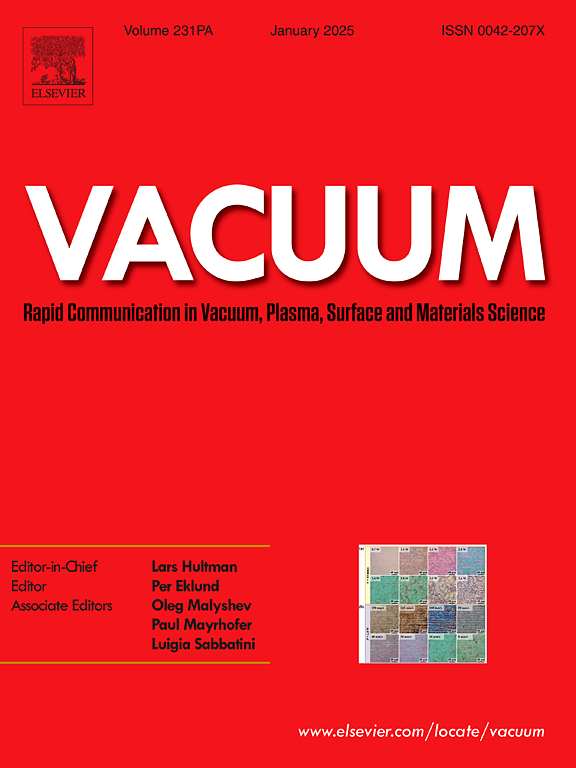Operational features of a wide-aperture forevacuum-pressure plasma-cathode pulsed electron beam source based on a planar magnetron (sputtering) discharge
IF 3.8
2区 材料科学
Q2 MATERIALS SCIENCE, MULTIDISCIPLINARY
引用次数: 0
Abstract
We describe our investigations of the operational features of a wide-aperture forevacuum-pressure plasma-cathode pulsed (0.5–1.5 ms) electron beam source utilizing a planar magnetron plasma discharge system. The accelerating voltage (up to 10 kV), which is used to extract, form, and accelerate the electron beam, influences the magnetron discharge initiation; increased acceleration voltage leads to a decrease in the initiation voltage and delay time of the magnetron discharge. This is due to a “parasitic” high-voltage glow discharge that occurs when high voltage is applied to the accelerating gap of the source. For gas pressure greater than 4 Pa, the magnetron discharge voltage is lower with electron beam generation. The magnetron discharge voltage decreases with increasing gas pressure (4–16 Pa) and accelerating voltage, and when argon is used rather than nitrogen. The electron emission current and hence e-beam current increases with increasing gas pressure. The observed decrease in magnetron discharge voltage and the change in emission properties of the magnetron discharge plasma are due to the “back-streaming” ion flux from the beam-produced plasma. The use of a planar magnetron discharge in the source ensures the formation of a wide-aperture (radius of up to 40 mm) electron beam with good homogeneity.
基于平面磁控(溅射)放电的大口径前真空压力等离子体阴极脉冲电子束源的工作特性
本文描述了利用平面磁控管等离子体放电系统的大孔径前真空压力等离子体阴极脉冲(0.5-1.5 ms)电子束源的工作特性。用于提取、形成和加速电子束的加速电压(高达10 kV)影响磁控管放电的起始;加速电压的增大导致磁控管放电起始电压和延迟时间的减小。这是由于“寄生”高压辉光放电发生时,高压施加到源的加速间隙。当气体压力大于4 Pa时,磁控管放电电压随电子束的产生而降低。磁控管放电电压随气体压力(4 ~ 16 Pa)和加速电压的增加而降低,且当使用氩气而不是氮气时。电子发射电流和电子束电流随气体压力的增加而增加。磁控管放电电压的下降和磁控管放电等离子体发射特性的变化是由于离子束产生的等离子体的“回流”离子通量。在源中使用平面磁控管放电确保形成具有良好均匀性的大孔径(半径可达40 mm)电子束。
本文章由计算机程序翻译,如有差异,请以英文原文为准。
求助全文
约1分钟内获得全文
求助全文
来源期刊

Vacuum
工程技术-材料科学:综合
CiteScore
6.80
自引率
17.50%
发文量
0
审稿时长
34 days
期刊介绍:
Vacuum is an international rapid publications journal with a focus on short communication. All papers are peer-reviewed, with the review process for short communication geared towards very fast turnaround times. The journal also published full research papers, thematic issues and selected papers from leading conferences.
A report in Vacuum should represent a major advance in an area that involves a controlled environment at pressures of one atmosphere or below.
The scope of the journal includes:
1. Vacuum; original developments in vacuum pumping and instrumentation, vacuum measurement, vacuum gas dynamics, gas-surface interactions, surface treatment for UHV applications and low outgassing, vacuum melting, sintering, and vacuum metrology. Technology and solutions for large-scale facilities (e.g., particle accelerators and fusion devices). New instrumentation ( e.g., detectors and electron microscopes).
2. Plasma science; advances in PVD, CVD, plasma-assisted CVD, ion sources, deposition processes and analysis.
3. Surface science; surface engineering, surface chemistry, surface analysis, crystal growth, ion-surface interactions and etching, nanometer-scale processing, surface modification.
4. Materials science; novel functional or structural materials. Metals, ceramics, and polymers. Experiments, simulations, and modelling for understanding structure-property relationships. Thin films and coatings. Nanostructures and ion implantation.
 求助内容:
求助内容: 应助结果提醒方式:
应助结果提醒方式:


